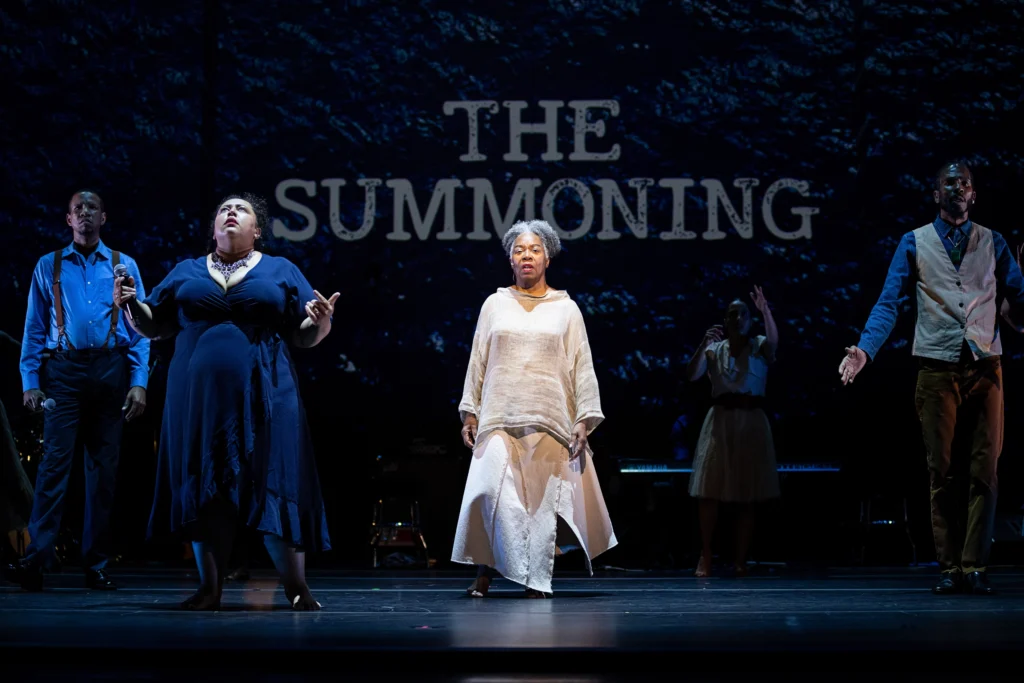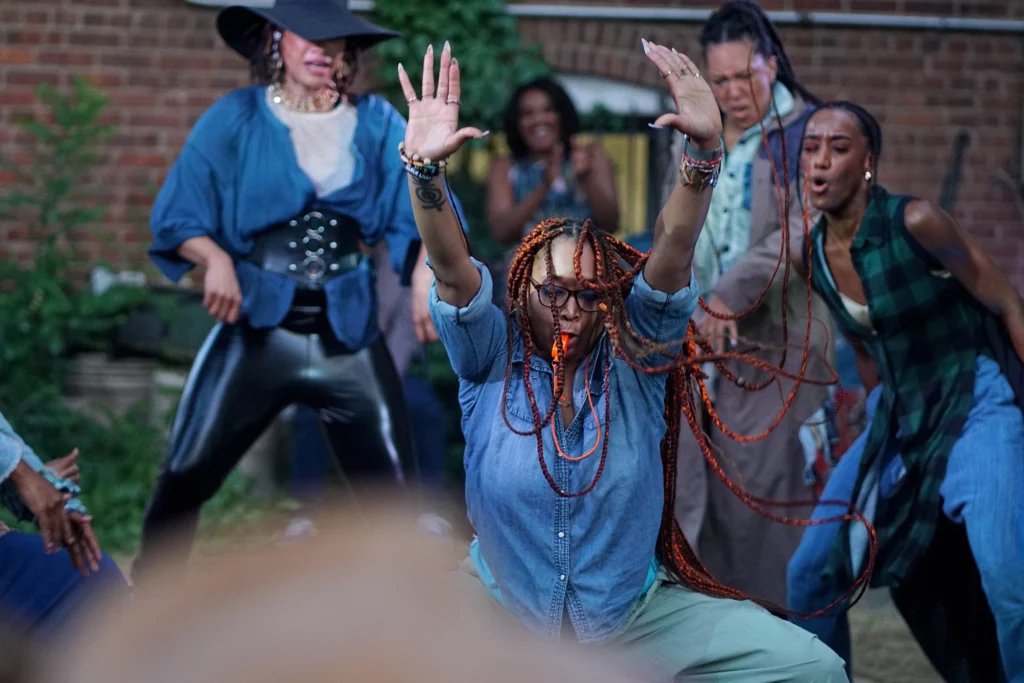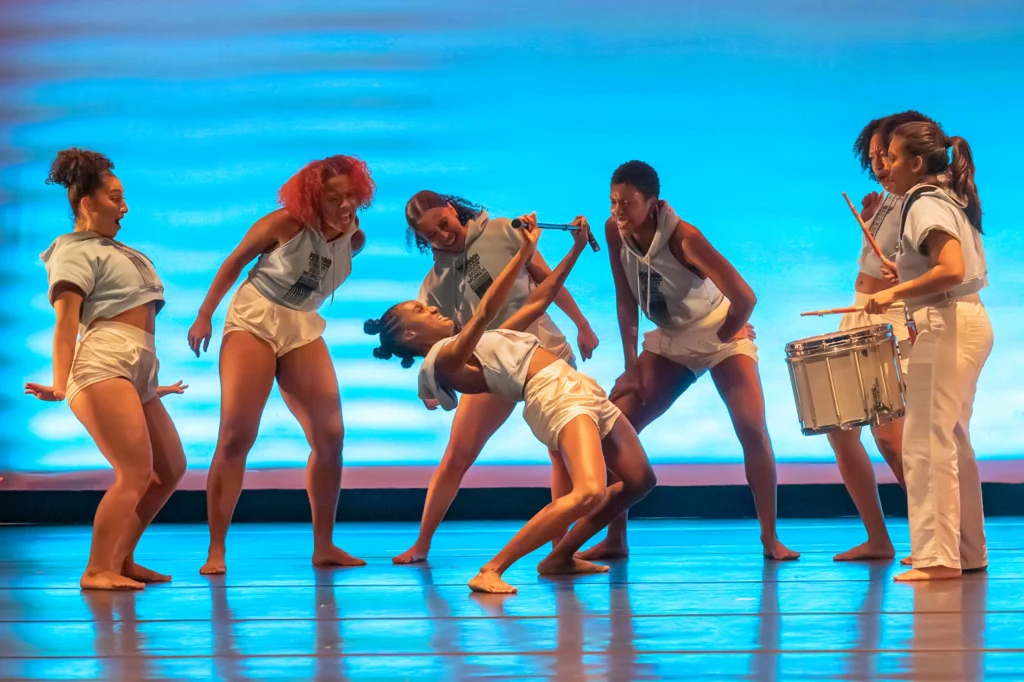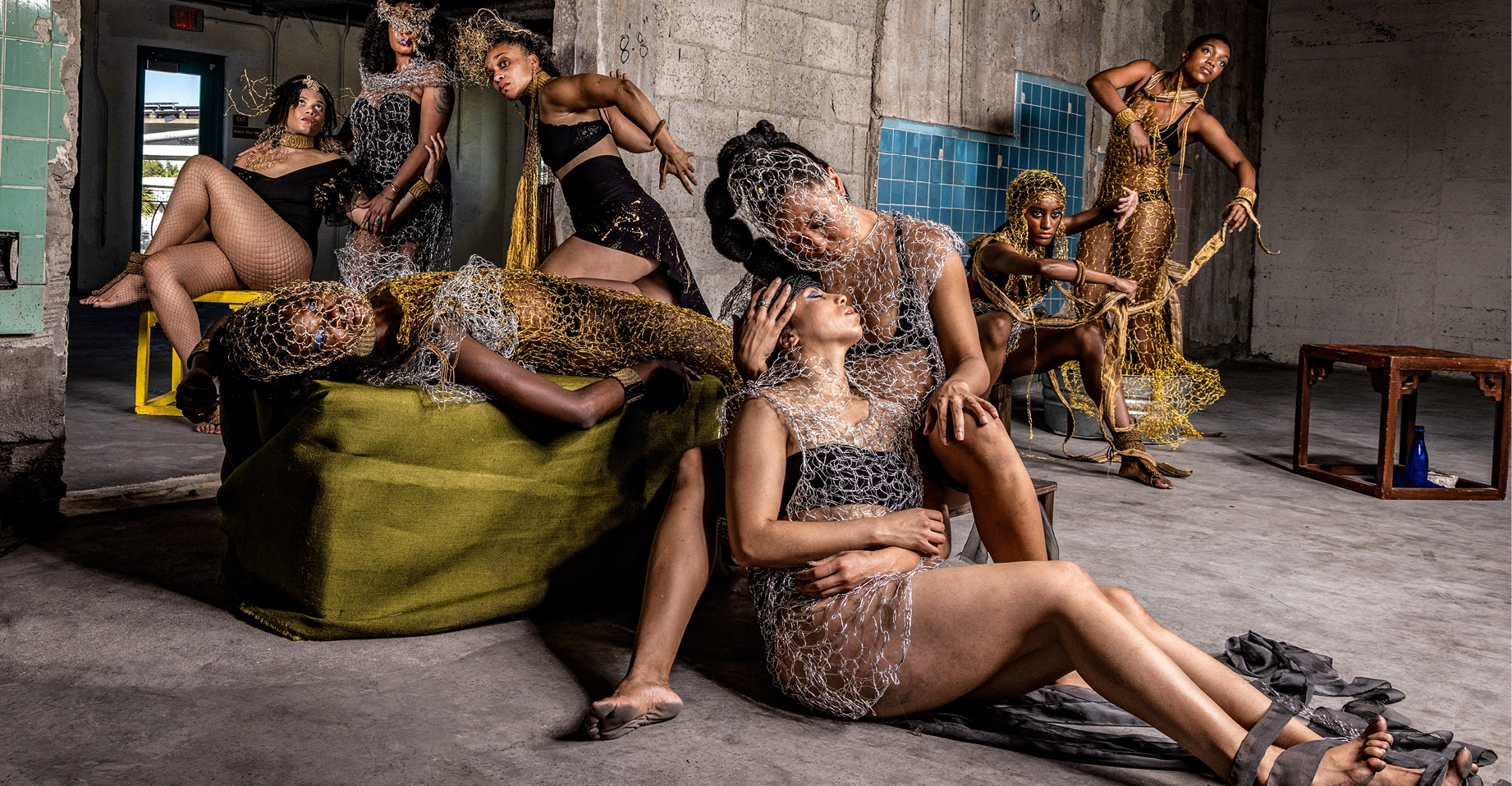What does it mean to sustain a Black-woman–led dance company for 40 years? What kind of vision is necessary? What are the key resources, broadly interpreted—not just money, but also people-places-things? What is the additional creative labor that leadership must take on to embed the company’s core values in every part of the work, and to engage communities in meaningful ways?
These are a handful of the curiosities I held when entering conversations with Urban Bush Women founder Jawole Willa Jo Zollar, and current UBW co-artistic directors Chanon Judson and Mame Diarra Speis. This year, the storied dance company celebrates four decades of creating and touring new works internationally, sharing its creative process and strategies for collaborating with communities, and cultivating the next generations of women+ of color performers, makers, facilitators, and producers.
UBW is now five years into a new artistic leadership structure, with Judson and Speis alongside acting executive director Tahnia Bell and producer Jonathan D. Secor at the helm of an almost 20-person team. Financially, UBW has been able to leverage significant institutional support, thanks to funds from MacKenzie Scott and the Ford Foundation’s America’s Cultural Treasures initiative. According to Zollar, for the first time in its history the company “can withstand some velocity,” although as recently as the pandemic shutdown in 2020 it “didn’t even have as much as one month’s operating cash reserve.”
As I spoke with two generations of artistic leadership, I noticed my head, shoulders, and torso nodding back and forth in what I call “full-bodied agreement.” In each conversation—first with Zollar, then with Judson and Speis—their words resonated deeply, as I’m currently navigating some of the same challenges they described within my own dance company. Across the country, dance groups and arts education programs alike are experiencing staggering cuts and shutdowns. What can we learn from UBW’s 40 years of operations to support a more sustainable future for dance?
In the spirit of sankofa—the Akan word that teaches us to hold our history while imagining our future—here are some of the lessons these leaders have uncovered in their stewardship of this organization.
Keep Experimenting
Zollar feels it is urgent that dance artists remain nimble. “There is an up and down to this field,” she says. “You can be really hot and then you can’t get anybody to return your phone call.”
While UBW’s mission—to bring untold and under-told stories to light from a woman-centered and African-diaspora community perspective—has remained constant, developing its administrative and programmatic operations has been an emergent process. “In the beginning, you just start doing your work,” Zollar says. “Over time a structure starts to evolve, and, honestly, our structure is always evolving. As the company changes, as the work changes, we’ve experimented with a lot of different administrative structures.”

Much of their big learning has been about taking an innovative approach to organizational practice. There have been intentional experiments that have yielded winning ideas—for example, borrowing the idea of a collaborative leadership structure from the world of community organizing. UBW has learned that having a small group of partners allows for reflectiveness and shared responsibility, but also the dexterity to make quick decisions.
Foster Collaboration
According to Speis, collaboration is critical to all UBW’s processes, whether in the studio crafting work or in an administrative meeting. This includes cultivating, maintaining, and deepening relationships with longtime partners—such as New Orleans–based Junebug Productions, dedicated to amplifying Black stories, and the People’s Institute for Survival and Beyond, which develops leaders in anti-racist community organizing.
Judson and Speis describe a culture within UBW borrowed from their artistic practice of ensemble design: witnessing your community and being witnessed, holding gratitude and respect for each other’s assets, and acknowledging “That is her excellence.” This makes space for each person’s gifts to shine, and for members to notice when someone else’s offering might better help the organization thrive.
Do Your Research
“At heart, I’m a researcher,” Zollar says. “I want to know how people have done things.” When the company faced what Zollar calls a “near-death” financial crisis, she sought advice and expertise from colleagues and mentors in the field, including- producers and arts consultants Laurie Uprichard and Baraka Sele. She also advises looking at how other industries have solved some of the same issues, and reading books on crisis management—for example, arts administrator Michael Kaiser’s book on his work with organizations like Alvin Ailey American Dance Theater. “The research helps ground you out of a reactionary place of emotion and opinion,” Zollar says.
Share Leadership
Judson and Speis say decision-making within UBW involves “overlapping circles” of input, allowing multiple voices to be heard. This is felt most in their Leadership Summits, all-staff meetings including everyone from company members to the marketing team. Acknowledging topics that impact the entire team and listening to each person’s experience brings another layer of awareness to decision-making.

With regard to their roles as co-artistic directors, Judson says: “Having other leadership voices for decisions helps to mitigate some separation, so that all roads don’t come to Mame Diarra and Chanon. It would make for a very heavy load for us, and a more delicate dance with our colleagues.”
Consider Care
Shared leadership is more than an administrative strategy; it is also a care practice. “I’m excited as a Black woman in co-leadership to not have to hold the roles in the ways that some of our mentors and predecessors had to,” Judson says. “We are able to be multiplicitous and whole. There are sacrifices we don’t have to make that were made in the past when we look at all the companies that were started by Black women. I’m grateful for their work and able to navigate in ways that are new.”
Both mothers, Judson and Speis also acknowledge the communal and familial aspects of UBW. Judson’s children understand that they are part of the community, and have contributed by filming rehearsals and watching younger children. For Speis, a co-leadership structure makes space for her humanity, allowing her to be a mother and a leader simultaneously. “Real life is happening,” she says, “and I can do both.”
The Next 40 Years
As UBW looks toward its next 40 years, Judson and Speis are thinking about what they call “strategizing and equalizing.” Excited to try on everything that interests them, they are leaning into experimentation. They are investigating where dance can happen outside of the theater, as well as new ways of embodying research from other fields. Judson says they are excited to “be with folks we know to be our audience, even if they don’t know they are our audience.” They are also meeting regularly to account for wins and “not-so-wins.” They are slowing down to be responsive—not reactive—in their decision-making, and to document methods and processes.
For Judson and Speis, it’s exciting to be simultaneously evolving and innovating. According to Speis, “It feels like everything is boundless.”
Seeding Ideas Across the Dance Field
Anyone who has experienced the Embodied History performance lecture during Urban Bush Women’s signature Entering, Building and Exiting Community Workshop may remember the distinct choreography of “outreach” versus “engagement.” The former is linear, an extended leg and a hand outstretched toward the ground, indicating hierarchy; the latter is a deep second position with the arms stretching away from the body through alternating horizontal shifts in the torso, indicating a preferred horizontal connection.

This embodied lesson on community engagement is one of many forward-looking ideas UBW’s programming initiatives have helped seed throughout the dance world. Those initiatives include BOLD (Builders, Organizers, & Leaders through Dance) workshops, like Entering, Building and Exiting Community; the Choreographic Center Initiative (CCI), which invests in the visibility of women+ of color choreographers; the Choreographic Center Initiative Producing Program, which cultivates the next generation of women+ of color producers; and their annual Summer Leadership Institute (SLI), where participants learn strategies to connect their art to community organizing.
With thousands of SLI participants since it began in 1997, the development of a rigorous training practice for skilled facilitators for their BOLD workshops, and generations of dancers who, according to Judson, have been cultivated as excellent artists inside their own voices, the UBW diaspora is extensive.
“There is a heartfelt commitment to holding the space that UBW has earned,” says Judson. She and Speis plan to continue to develop UBW as both a model and a resource for other dance organizations.
Looking Forward and Backward, Onstage and Off

As a choreographer, Zollar forged space for Black girlhood and womanhood on the concert stage. She also created unique movement languages for each ensemble piece, instead of establishing a codified technique. These practices were groundbreaking in the 1980s and opened doors for artists like Camille A. Brown and MK Abadoo, who continue to make work in those traditions today. Zollar’s final work for UBW—the semi-autobiographical SCAT!… The Complex Lives of Al & Dot, Dot & Al Zollar, which premiered in June—hearkens back to and celebrates these artistic roots.
To keep cultivating creative practices inside the company, UBW has begun the process of developing an innovation reserve, so that UBW can sponsor projects that require risk but may not always align with funding trends. The new leaders are pushing boundaries in performance, too. The next leg of UBW’s 40th anniversary tour, titled This Is Risk, begins this fall, anchored by Judson and Speis’ dance-theater work Haint Blu, which considers the healing power of ancestral wisdom.
Zollar is currently working on The Storied Body, The Storied Stage, a book and a series of workshops and lectures documenting 40 years of building her creative practices. And to preserve Zollar’s legacy in the longer term, UBW’s board is building trust structures similar to those that maintain the catalogs of George Balanchine and Merce Cunningham. Of the necessity of protecting Zollar’s works, Judson says, “We are not all inside our liberation. The opposition is there. It feels important to hold that legacy.”
